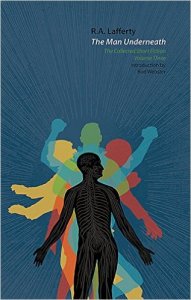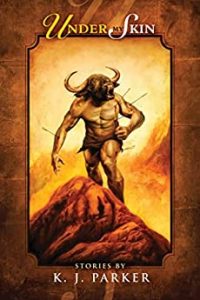Paul Di Filippo reviews R.A. Lafferty
The Man Underneath: The Collected Short Fiction, Volume Three, by R.A. Lafferty (Centipede Press 978-1613471647, $45, 368pp, hardcover)
 In 2011, Michael Swanwick, in a blog post, was one of the first to report on the then-distressful state of the literary legacy left behind by R. A. Lafferty. In short, all of Lafferty’s work was unavailable. But the good news was that Lafferty’s estate was moving forward to remedy the lamentable situation by selling all rights to his works en masse to the Locus Science Fiction Foundation, parent entity of all things Locusian. Neil Gaiman also played an important role in this process.
In 2011, Michael Swanwick, in a blog post, was one of the first to report on the then-distressful state of the literary legacy left behind by R. A. Lafferty. In short, all of Lafferty’s work was unavailable. But the good news was that Lafferty’s estate was moving forward to remedy the lamentable situation by selling all rights to his works en masse to the Locus Science Fiction Foundation, parent entity of all things Locusian. Neil Gaiman also played an important role in this process.
Fans of the ineffable Lafferty (a fine interview between Lafferty and Tom Jackson was reproduced online a year ago) immediately rejoiced, dreaming of a day when not only all of the stories and novels that saw print during his lifetime would reemerge for sale, but also all of the hard-to-find small-press books (many produced by the invaluable Chris Drumm) would get sorted, and then, finally, whatever was left in manuscript at Lafferty’s death that deserved printing would arrive. According to Lafferty expert Jonathan Strahan, this latter trove includes over a dozen novels, with alluring titles such as In The Akrokeraunian Mountains and Iron Tongue of Midnight, as well as about eighty short stories and a handful of essays. And all of this stuff would appear in editions calculated to capture the largest number of new and old readers.
Well, five years later, we have to acknowledge a mixed progress, quite admirable but bounded nonetheless by economic realities and the cult appeal of Lafferty himself. And so, indeed, all of the short stories, Lafferty’s primary métier, are getting reprinted. But they are not appearing in economical formats designed to attract newbies. Of the novels, both extant and unknown, we hear not a word. Still, what has been achieved is nothing to sniff at, and I, for one, am extremely grateful.
Centipede Press is the noble enterprise handling the Complete Stories. They have just issued Volume 3, which is our topic for today. The upside of their output is that each volume is lovingly produced, a luxury item that is a tribute to the artistry of the small press. (Designer Jacob McMurray plays no small part here.) The downside is that each book is limited to 300 copies, and is naturally more pricey than a corresponding hardcover from the Big Five. If purchased from Centipede’s site, a Lafferty book costs $45.00—if it hasn’t sold out. Via other sellers, you’ll pay from $60.00 to $100.00. Lord knows what the collectible price will soon be!
While fully in line with other specialty titles, this cost and limited print run is not going to attract new readers. Instead, it’s drawing in old-time fanatics like myself. Not necessarily a sad or bad outcome, but I am tempted to compare this venture to the amassing and marketing of The Collected Stories of Theodore Sturgeon by North Atlantic Books, which sold in hardcover for less; seemed, from what I could see, to have larger print runs; and also migrated to paperback and ebook formats eventually, at least for early volumes.
But perhaps I am comparing pomegranates to kumquats. In any case, cheaper editions might yet loom in the future. So let’s turn our attention to what we have now.
I devoured all the Lafferty I could get as a teenager, many decades ago, and imprinted deeply on it. In later years, I have not had a chance to revisit the canon, except for a story here and there (including my two favorites, of course: “Nine Hundred Grandmothers,” included in this volume, and “Slow Tuesday Night.”). So this current offering that features a generous nineteen stories was to me like diving into some forgotten ancestral lake.
But before talking about a subset of those tales, let me mention the “Introduction” by Bud Webster and the “Afterword” by John Pelan. The former is a reprint of one of Webster’s “Past Masters” columns, and as such is a rich and thoughtful examination of Lafferty’s whole career, not just an exegesis on these nineteen selections. Bud Webster, as some might have heard, passed away recently, and reading this piece, one acknowledges sadly just what a loss that passing was for the whole field. Pelan’s shorter and more specific account of how he assembled the collection (stories date from 1960 to 1986) contains the valuable insight that even old-timers will find newnesses when reapproaching these tales.
Prior to trying to capture what makes Lafferty’s style and plotting and characterization so special, I’ll just toss out a few of the conceits he deploys, which were equally unique.
The title story features a magician who conjures up his own doppelganger and eventually must wage a battle for primacy with the other man. “Selenium Ghosts of the Eighteen Seventies” features a counterfactual “dead media” platform and the artworks it engendered, all thickly detailed. The search for the ABSM—Abominable Snow Man—oddly enough takes the reader to the parched, haunted landscape of “Boomer Flats.” “The Hellaceous Rocket of Harry O’Donovan” is a political screed about the grooming of candidates that could have been written today about the contests of 2016. Likewise, “Thou Whited Wall” reads now like a prescient parable of social media, with its twelve loud-mouthed wall scribblers. “The Wooly World of Barnaby Sheen” reprises Sturgeon’s “Microcosmic God,” but with a race of fleas. Lafferty might have had van Vogt’s “Black Destroyer” in mind in “Snuffles,” the story of a murderous bear-boy-alien-demiurge, but chose to add cosmic and theological layerings. And “The Last Astronomer” postulates “the collapse of the classic Hubbleian astronomy” in a manner that would do Greg Bear proud.
But no matter what oddball novum Lafferty trotted out of his capacious brain bag, oftentimes peppered with additional throwaway croggling fillips, the tropes and action were swaddled in the same royal jelly style. (How’s that for a mock-Lafferty sentence?) I would derive his main influence from the arch and ironic linguistic posturings of S. J. Perelman, admixed with Mike-Fink-Paul-Bunyan American tall tales. Then you would have to factor in some borrowings from Bradbury when most lyrical. Peers who might have influenced or at least resonated with Lafferty would include Donald Barthelme, Avram Davidson, David Bunch, and even Cordwainer Smith for that sense of mythic recountings. As for Lafferty’s descendants, in part or in whole, I’d call to the stand Andy Duncan, Howard Waldrop, Barrington J. Bayley, and Gene Wolfe.
Lafferty’s characters, of course, could not be drawn naturalistically to consort with such a wild-eyed style, and so are fabulaic and otherworldly, often reappearing from story to story as a kind of Commedia dell’arte troupe. Nonetheless, they carry emotional and spiritual burdens quite well and impactfully. As for Lafferty’s plotting, it merely seems arbitrary and stream-of-consciousness. He knew how to chart rising tension and suspense and deliver a sharp climax as well as any thriller writer.
Add up all these traits, and you get tales that are at once postmodern and ancient; funny and tragic; capricious and predestined; broad yet subtle. They would seem to accurately convey the nonpareil mind and heart and weltanschauung of the writer himself, who in all likelihood would have agreed with Oscar Wilde when the playwright said, “Life is far too important a thing ever to talk seriously about it.”






An excellent piece. It’s good to see Lafferty being remembered. I toyed with the idea of buying these books, but decided it was a high price to pay for a few stories I didn’t already have in book form. As you say, the Sturgeon set from North Atlantic Books was an essential purchase, as was the Zelazny set from NESFA Press, this set, I think is less so.
More toward James Branch Cabell than S.J.Perelman for his style. Certainly more tall tale than Paul Bunyan (who was made up for advertising). Certainly his knowledge of Latin glimmers in his mixings of English. The more you read of him, the clearer he seems to be.
In my previous comment, either removed or still awaiting moderation, I said I had read somewhere online–now forgottend–that someone who had published both David Bunch and R.A. Lafferty said they were not admirers of the other’s work. I found it:
https://lareviewofbooks.org/article/an-ode-to-new-metal-man-david-bunchs-moderan/